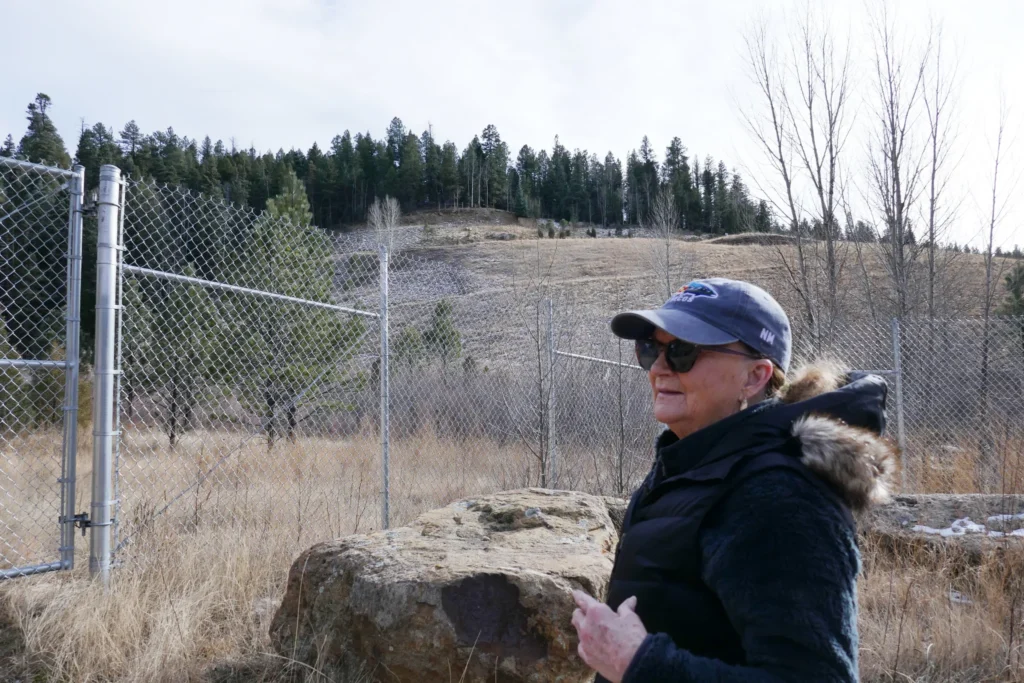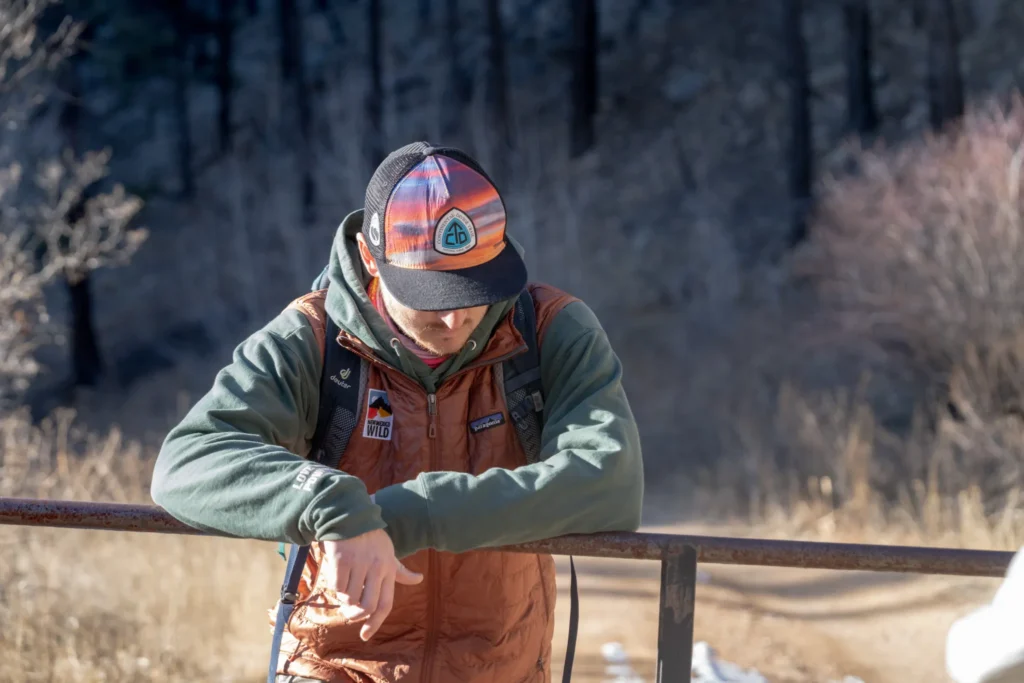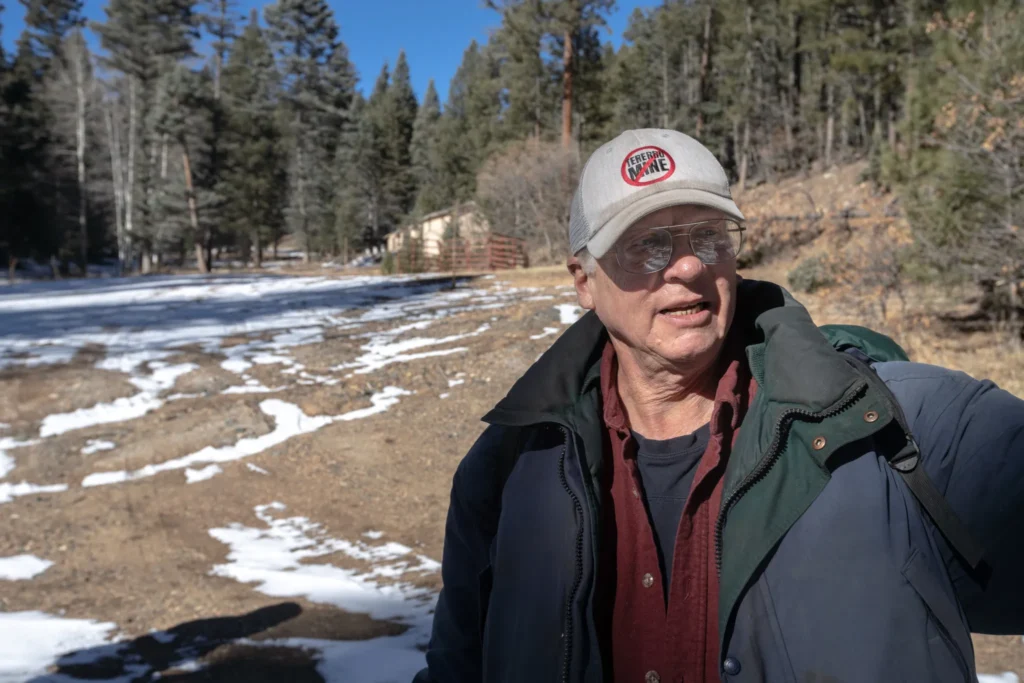A unique NM coalition is battling the project to prevent widespread harm — and deja vu.
by Alicia Inez Guzmán/ Searchlight NM
“Pecos Mine Site Reclamation Project. No Trespassing,” the sign on the fence reads. As Ralph Vigil takes in the warning, he once again has a sinking feeling that the past is about to repeat itself.
Nearly 100 years ago, the old Tererro mine tore up this area, causing decades of harm to the forests, waterways and aquatic life. Standing amidst a landscape that has never fully healed, Vigil and other locals now turn their attention to the future. Eight miles from where they stand, a multinational corporation is hoping to mine untold tons of ore, threatening the fragile ecosystem once again. The name of the new venture: Tererro VMS Project.
“We gotta fight this,” Vigil says. “Our fight is for madre tierra.”
In June 2019, news of the proposal hit like a blow: Comexico, an American subsidiary of the Australian company New World Resources, sought to drill exploratory cores in the southern end of the Sangre de Cristo Mountains, a remote and dense tangle of Ponderosa pines, douglas fir and rambling creeks about 15 miles north of Pecos. The landscape holds legendary trout streams and picture-postcard vistas. It also holds an estimated 5.7 million metric tons of gold, silver, zinc, copper and lead.
Exploration would start as a relatively small operation in the Santa Fe National Forest — spanning less than 10 acres — but a full-scale mine could eventually sprawl across hundreds or thousands more acres and overwhelm the winding two-lane highway with trucks and machinery commuting up and down the mountain.
Within a week of hearing about Comexico, Vigil — a Pecos resident, organic farmer and chairman of the New Mexico Acequia Commission — was sitting down with community members and environmentalists, sketching out a plan of resistance. The coalition that emerged was historic, in his words. Groups that didn’t normally see eye to eye — acequia advocates, Indigenous leaders, environmentalists, outdoorsmen and women and government officials — all joined together under one banner: Stop Tererro Mine.
The past, they believed, was a harbinger of what was to come. The old mine operated a mere 13 years before it was shuttered in 1939, but the damage it exacted endured for generations. Willow Creek, at the foot of Elk Mountain, ran the color of rust for decades owing to the unusable ore — or waste rock — that was left to languish along its banks. Periodic rains and spring thaws sent acidic runoff into nearby waterways, polluting them with heavy metals.
The most devastating day came in the spring of 1991, when the toxic runoff rushed into the Pecos River, the lifeblood of the region. Sulfuric acid, aluminum and zinc wiped out 90,000 Rio Grande cutthroat trout at the Lisboa Springs Fish Hatchery downstream and another 10,000 in the river. The disaster almost wiped out an entire local economy built around angling, hunting and camping.
A cleanup of that site, and of El Molino, a mill on the outskirts of Pecos, followed. The area was contaminated enough to be designated a federal Superfund site, but residents, public officials and others believed the cleanup could be done better — and without the stigma of a Superfund designation — if it was undertaken differently.
As a result, the New Mexico Environment Department (NMED), several other state agencies and Freeport-McMoRan, the company held responsible, agreed to a cleanup through a consent order. The remediation has cost New Mexico taxpayers at least $8 million, Gov. Michelle Lujan Grisham has estimated: “Money is spent annually on studies and sampling with no end in sight,” she added. Much has been restored in the past 30 years, but the process is still not complete.
Questions about the old mine have lingered ever since, including whether the contaminated water could have caused illness or death in downstream communities, like Pecos. But no health studies were ever conducted as part of the legal agreement, making it almost impossible to find out.
“Whether we’re Hispano, Pueblo, or just people who love to hunt and fish and hike, that’s what unites all of us around this thing: We all want to turn on the tap and not have poison water,” said Garrett Vene Klasen, a Stop Tererro Mine coalition member and conservation director for NM Wild, a nonprofit dedicated to protecting the state’s wilderness.
Core goals
Hiking along a rough Forest Service road by Indian Creek — one of several waterways near the proposed exploration site — coalition member Stephen Nelson recalls how the water ran yellow in the late 1970s, during Conoco’s exploration of the so-called Jones Hill Deposit, named for 19th-century prospector Johnie Jones.
Conoco ended up abandoning the project. But its explorations rendered much of the data that Comexico is now using to direct its own venture, which involves drilling an estimated 30 bore holes — up to 4,000 feet deep — into Jones Hill in the first phase. The long-term goal is to exploit all of the region’s many riches.

Comexico declined to answer specific questions from Searchlight New Mexico; the company will address public comments at a hearing in the future, exploration manager Pat Siglin stated by email.
But according to Comexico’s website, “the company’s ultimate objective” is to develop a “centrally located processing facility that is fed by ore from multiple deposits” and to lay the foundations of a “significant” new camp. To put it into perspective, Comexico intends to extract more than double the amount of ore that was processed at Tererro all those years ago.
The area holds undeniable promise. According to Dennis McQuillan, a retired geologist who worked at NMED and participated in Tererro’s long-term remediation, the “gold-rich Jones Hill ore body is part of a cluster of volcanic massive-sulfide (VMS) ore bodies in the region that are collectively the largest of their kind in New Mexico.”
Besides gold, the area holds deposits of copper, zinc, lead and silver, all forged by ancient volcanoes over millennia. And all are in demand. The United States Geological Survey includes zinc — used in building materials like gutters and galvanized nails — in its 2022 list of critical minerals. (The Biden administration recently recommended expanding domestic mining of these minerals to combat the “over-reliance on foreign sources.”)
Traditional Pueblo cultural sites, acequias, a vibrant recreation industry, habitats that support at-risk and endangered species — all would be imperiled if the project moves forward, coalition members argue. They cite the old Tererro Mine as a cautionary tale.
“Mining would benefit a rich corporation and a few people that are gonna make money on it, but not the community and not our heirs in our future,” said Janice Varela, a local watchdog and San Miguel County commissioner. “Our livelihoods are at stake.”

Old law rears its head
The coalition’s battle isn’t just against Comexico, though. It’s also against the General Mining Act of 1872, which grants the right to prospect and mine on federal lands. The majority of the company’s mining claims are within such federal property — the Santa Fe National Forest.
“That mining law is what needs to be changed, because no tribes were invited to the table when it was made,” said Michael Martinez, a member of Ohkay Owingeh Pueblo and the Reserved Treaty Rights Lands Coordinator for Tesuque Pueblo. “They would’ve all said no.”
Lands stretching all the way to Lake Katherine in the Pecos Wilderness make up a broader “Pueblo world,” said Joseph “Brophy” Toledo, a spiritual leader at Jemez Pueblo who also has roots in Tesuque Pueblo and the historic Pecos Pueblo. Ceremonies are still performed there, Toledo, an herbalist, added. “That is a very sacred place to my people.”
“Our anatomy is the same as Mother Earth’s. And when you look at yourself as an Earth person, everything that is on Mother Earth is part of you. When mining companies come in and they start drilling, it’s like them drilling through you…They’re going through all your veins, your arteries, and they’re going through the heart.”

Signed by Ulysses S. Grant to encourage westward expansion, the 1872 law is widely reviled and has been characterized as a “sustained, systemic swindle.” But it’s been baked into the system for so long that it’s almost impervious to revisions. In 2020, the All Pueblo Council of Governors passed a resolution supporting “federal legislation to reform the 1872 Mining Act to protect Pueblo lands, sacred sites and water resources.” But the U.S. House bill they were backing failed to make it out of committee.
“The law really needs to be improved so that mining rights and claims can be denied when the environmental consequences are so high,” said Sally Paez, staff attorney at NM Wild.
But until Congress overhauls it — a revamp the Biden administration admits is needed — the archaic law will continue to rear its head. It did so last year when the Santa Fe National Forest proposed an 11,600-acre Thompson Peak wilderness management area that would have barred development on 1,300 acres claimed by Comexico. The company challenged the decision by evoking the takings clause of the Fifth Amendment, or the “taking of property rights without just compensation,” as its November 2021 objection read.
The effect of the objection was chilling. The Santa Fe National Forest’s original proposal would have largely prevented Comexico’s access to its minerals. After Comexico’s challenge, however, the SFNF cited a discrepancy in its analysis and accommodated the company’s claims. In the agency’s final record of decision, the Thompson Peak proposed wilderness had shrunk by 2,000 acres.
“Comexico is asserting the right to prospect, and federal mining laws and regulations require the Forest Service to allow mineral exploration and development on National Forest System lands,” Julie Ann Overton, SFNF spokesperson, explained by email. “We have no choice.”

‘Death by a thousand cuts’
The 1872 Mining Act is a formidable foe, but the Stop Tererro Mine coalition has alighted on a strategy to fight it, according to Lela McFerrin, vice president of the Upper Pecos Watershed Association. The plan is to weigh down the largely bureaucratic permitting and approval process with even more bureaucracy.
Among the actions to date: In 2019, Santa Fe County passed a mining ordinance with strong environmental protections; San Miguel County followed suit in 2021. Numerous tribes — from the Jemez, Tesuque and Santa Clara Pueblos to the Hopi and the Comanche — registered disapproval or called for government-to-government consultations to stop the project. Along with local community organizations, they demanded a full environmental assessment, which significantly slowed the permitting process.
A long list of top government officials also lined up in opposition. The state’s congressional delegation is currently lobbying for an “administrative mineral withdrawal” from the Department of the Interior, which would take any future mineral claims off the table and prevent other companies from following in Comexico’s footsteps. And in 2022, the Pecos River and all its tributaries were designated Outstanding National Resource Waters, “the highest level of protection against degradation” under New Mexico’s water quality standards.
In addition, the coalition is developing a proposal that includes a package of land protections. One involves a wilderness designation at least 4,000 acres larger than SFNF’s recommended Thompson Peak area. Once completed, that proposal will go directly to New Mexico’s congressional delegation to be crafted into legislation (ultimately, Congress will decide the extent of the protections). Going to court isn’t off the table either.
“We call it death by a thousand cuts,” McFerrin said.
As of now, Comexico’s plan of operations is on hold because Santa Fe National Forest staffers, preoccupied with the Hermit’s Peak Calf Canyon wildfire, have not been able to complete the environmental assessment.
The New Mexico Energy, Minerals and Natural Resources Department will render its final decision on Comexico’s exploration only after the SFNF releases that report and a public hearing is held. And while the SFNF can’t prohibit mining outright, the agency can implement measures that would mitigate its environmental impacts, Overton said. That can include, for example, limiting exploration to times in the year when the Mexican spotted owl isn’t breeding.
In the end, approval for the exploration is all but guaranteed, come spring or summer, as James Duran, acting forest supervisor of the SFNF, assured Comexico in a letter last August. But even if the proposal is approved, the coalition is hoping that at least one of its roadblocks will mire the process in so much red tape, or make it so costly, that mining ultimately becomes impractical.

Aerial views
In early December, Ralph Vigil invited coalition members to board a six-seater plane that would take them above Jones Hill and neighboring Thompson Peak, Comexico’s primary targets for exploration. Tribal members, acequia parciantes, congressional staffers, county commissioners, and environmentalists crammed into EcoFlight’s Cessna 210, in one of three waves.
As people milled around the Santa Fe Airport lobby waiting to board, the conversation turned to wilderness designations. These serve to keep landscapes wild and untouched while preserving cultural resources and sacred sites, according to NM Wild. But while the designations keep out motorized vehicles and machines, some say they have historically kept out locals, too. Case in point, the Pecos Wilderness. Its designation made it almost impossible to gather firewood — and thin trees and underbrush — unless one wanted to ride in on horseback with a hand saw.
And lack of thinning by the U.S. Forest Service both within and outside of the wilderness has left the area with unchecked growth. From the skies this was obvious. Passages of dense greenery — too dense, many commented — alternated with stretches of desolation, bald areas wiped out by one wave after another of catastrophic wildfire.
The coalition doesn’t want Aldo Leopold’s version of wilderness — untrammeled and unpeopled. What members seek instead are lands that thrive because they are accessible, not to mention safe from another chapter of extraction.
Until then, it’s painful to watch distant companies like New World Resources be given the benefit of the 1872 Mining Act, coalition members lamented. Many felt as if the Australian company had more say on the future of their lands and water than they did.
“They’re not here. Their roots aren’t embedded in the ground,” said Martinez. “Ours are.”

Searchlight New Mexico is a nonprofit, nonpartisan media organization that seeks to empower New Mexicans to demand honest and effective public policy